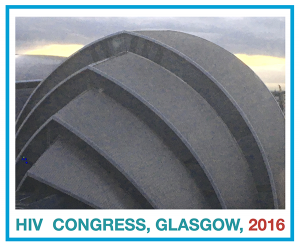Once-weekly albuvirtide infusion: early results of T-20-like compound
29 November 2016. Related: Conference reports, Antiretrovirals, HIV 13 Glasgow 2016.
Simon Collins, HIV i-Base
Partial interim results were reported for the entry inhibitor albuvirtide, a long-chain peptide active against gp-41, similar to enfuvirtide (T-20), by Dong Xie from Frontier Biotechnologies, the Chinese pharmaceutical company developing this compound. [1]
Albuvirtide is being developed in China as an alternative second-line combination, where access to oral drugs is limited (no integrase inhibitors, or second-generation NNRTIs or PIs). Early studies reported mean viral load reductions of about 1.0 log copies/mL in treatment naive participants using the 320 mg dose following multiple doses over six weeks. [2]
Differences between albuvirtide compared to T-20 include a plasma half-life of 12-14 days allowing once-weekly intravenous infusion (rather than twice-daily sub-cutaneous injections) and a side effect profile that does not include injection site reactions (ISRs).
This is an open label phase 3 non-inferiority study that randomised 389 treatment experienced participants to a second-line combination of lopinavir/r plus either albuvirtide or WHO-recommended NRTIs. Entry criteria included having viral load >1000 copies/mL on first-line ART.
The study is being run at 12 sites in China with about half of participants coming from urban and half from rural sites. The primary endpoint is the percentage of participants with viral load <50 copies/mL at week 48. Participants in the albuvirtide arm required weekly clinic visits compared to 3-monthly visits for the control arm.
Baseline characteristics included mean age 40 years (SD +/- 11) and 25% were women. Mean CD4 count and viral load were approximately 240 cells/mm3 (SD +/- 140) and 3.8 log (+/- 1.0 log) copies/mL (with 10% having >100,000 copies/mL). Overall, 80% had at least one major drug resistant mutation, with most having both NNRTI and NRTI mutations. Approximately 75% of participants were using tenofovir at baseline.
This interim analysis included 208/389 participants, with results available for 175/208 participants in the modified ITT analysis: 83 vs 92 at 24 weeks and 50 vs 48 at 48 weeks, in the albuvirtude vs NRTI groups respectively.
Although both groups showed 80% viral suppression at 24 weeks, by week 48 rates were 80% vs 66% in the albuvirtide vs control group respectively (difference 14.4%, 95%CI: -3.0 to 31.9). This showed non-inferiority at both time points.
Tolerability was good and most side effects seemed comparable between groups: about 75% reported side effects (mostly mild diarrhoea) with only 5 vs 3% classified as serious events (only one of which, GI-related in the NRTI group, was drug-related). No ISRs were reported.
Based on these results, albuvirtide has already been submitted for conditional approval in China and there are plans to run additional international studies in other countries next year, especially if paired with other long-acting drugs.
Comment
These promising early results are interesting as this compound has a unique profile to currently approved drugs and it would likely help people with current multi-drug resistance, including to integrase inhibitors, who are dependent on new drugs.
A sub-cutaneous formulation of albuvirtide is also in development that would allow self-injections at home, rather than weekly clinic visits.
T-20 is now extremely rarely used, largely due to difficulty with injections.
References:
- Wu H et al. Efficacy and safety of long-acting HIV fusion inhibitor albuvirtide in antiretroviral- experienced adults with HIV-1: interim 48-week results from the randomised, controlled, phase 3, non-inferiority TALENT study. Glasgow Congress on HIV Therapy, 23-26 October 2016 (Glasgow 2016). Oral abstract O336. Webcast:
https://vimeo.com/189136480 - Wu H et al. Albuvirtide, the first long-acting HIV fusion inhibitor, suppressed viral replication in HIV-infected adults. 52nd ICAAC, 9-12 September 2012, San Francisco. Abstract H554.
http://www.abstractsonline.com/Plan/ViewAbstract.aspx?sKey=e1c18d5b-830f-4b4e-8671-35bcfb20eed5&cKey=70d14bcc-bad6-4754-b4b1-66b7d2559a23&mKey=%7b6B114A1D-85A4-4054-A83B-04D8B9B8749F%7d


